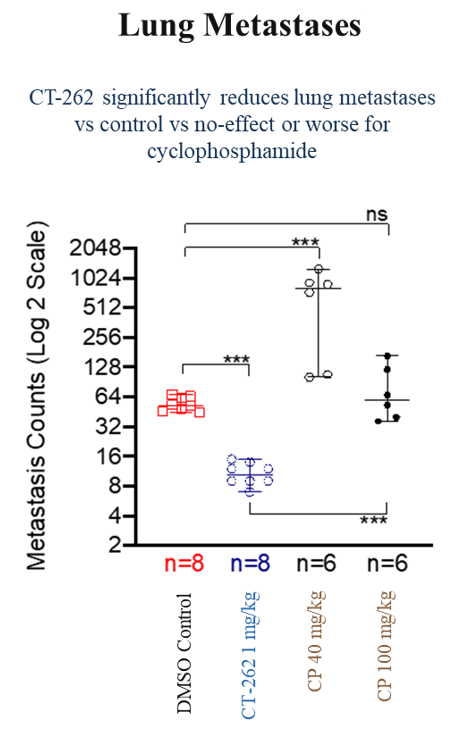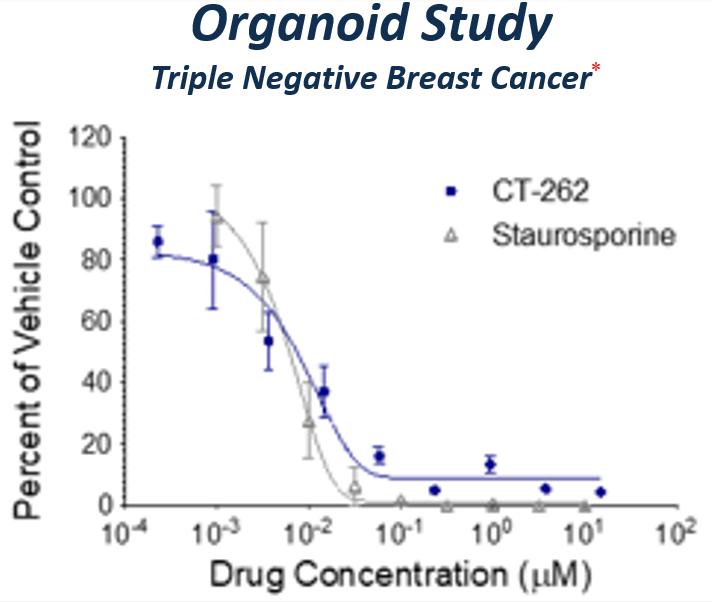Studies
Preclinical Studies
Due to its unique design, administration of CT-262 showed astonishing efficacy and survivability in a mouse leukemia model
– In vivo mouse leukemia model where animals were dosed only 3 times (days 1 , 5 , 9 )
– CT-262 showed initial survival well beyond other cytotoxics
– Because the response was so remarkable, study was extended to one year, where surviving animals represent long-term survivors with no evidence of delayed toxicity
-
60% of mice dosed at 2.5 mg/kg survived at least one year
-
40% of mice dosed at either 0.5 mg/kg or 1.0 mg/kg survived at least one year
– Implies CT-262 will have a wide therapeutic window in humans
CT-262 administration reduced fat pad masses to
non-cancerous levels in transgenic breast cancer mouse model
non-cancerous levels in transgenic breast cancer mouse model
Highly aggressive tumor model that mimics both early-stage and advanced (stage 2/3) cancer, as well as metastatic lung tumors
CT-262 administration was highly effective in both early and later-stage breast cancer models
Only high dose cyclophosphamide (CP) showed a reduction in fat pad mass, and not to the same extent as CT-262

Treatment with CT-262 also significantly reduced lung metastases in this breast cancer model
-
Highly aggressive tumor model that mimics both early-stage and advanced (stage 2/3) cancer, as well as metastatic lung tumors

Importantly, administration of CT-262 was not associated with the treatment-limiting myelosuppression associated with typical chemotherapy
Equally and highly efficacious doses of CT-262 and cyclophosphamide (CP) result in markedly different impacts on WBC levels
This suggests that CT-262 administration has much less impact on the bone marrow than CP

CT-262 showed extremely high potency in
2-dimensional cell culture models
2-dimensional cell culture models

Similar potency shown all 15 cell types studied
- Triple Negative Breast Cancer
- Colon Cancer (HCT-15)
- NSCLC (NCI-69)
- Multiple Myeloma
- Pancreatic Cancer (AsPC-1)
- Liver Cancer
- B Cell Lymphoma
- Leukemia
- Colon Cancer (MCT-116)
- Prostate Cancer
- Melanoma
- NSCLC (A549)
- Osteosarcoma
- Pancreatic Cancer (Panc1)
- Glioblastoma
Using state-of-the-art human organoid models, studies show that CT-262 administration was effective against 7 forms of cancer.
Organoids
- Driven by human cancer stem cells, tumor organoids bridge a gap between conventional 2-D cell line cultures and in vivo models
- CT-262 showed complete response in all 7 organoids tested with slowest growing tumors taking longer to manifest full effect
- Importantly, cisplatin showed only a partial response in the 5 organoids tested where cisplatin was studied, with ≥ 100x higher IC50 values3
- Organoid models have been shown to have high predictability for efficacy in humans
- Pancreatic Cancer*
- Colon Cancer*
- Gastric NEC Cancer*
- Metastatic Melanoma
- Ovarian Cancer
- NSCLC*
*Tumor type highly resistant to therapy

